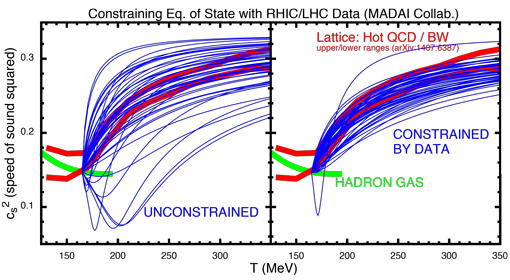Research by Scott Pratt
Modeling Tools for Collisions
by Scott Pratt
As matter is heated to temperatures above 150 MeV ($\approx 10^{12}$ Kelvin) it becomes so dense that normal hadrons, e.g. protons or neutrons, overlap and a new state of matter emerges, the quark gluon plasma. These conditions, which existed a few microseconds into the evolution of the universe, are recreated in the dense and hot environments created by colliding heavy ions at the Relativistic Heavy Ion Collider at Brookhaven National Laboratory or at the LHC at CERN.
A central goal of the RHIC and LHC programs has been to extract the equation of state of the super-hadronic matter created in the collisions and to compare it to idealized theoretical calculations from lattice gauge theory for an equilibrated system. Because the hot matter created in collisions expands and cools to a normal hadronic state in under $10^{-22}$ seconds, and because measurements are confined to the momenta of final-state particles, extracting properties of the ephemeral matter requires detailed and careful modeling. The MSU group has developed a wide range of modeling tools that describes the entire evolution of the collision. Tools include initial state physics, a relativistic viscous hydrodynamic module, a hadronic simulation for the final breakup stage, and special theoretical tools for calculating interferometric source sizes. Additionally, the Group has developed a toolset for performing a Bayesian analysis to simultaneously compare numerous classes of observables to the model, which incorporates 14 parameters to incorporate the large uncertainties associated with the description. In this analysis the equation of state, speed of sound vs. temperature, was varied by freely adjusting 2 parameters, with 50 representative samples of the random equations of state shown in the left-side panel. After the statistical analysis, 50 new parameters were chosen according to the posterior likelihood coming from comparing to experiment. These 50 representative equations of state, seen in the right-side panel, are remarkably consistent with the equation of state calculated in lattice gauge theory. This is the fields first global analysis of model and data and has resulted in the field’s first rigorous determination of the equation of state from experimental data. This shows that the stress-energy tensor, which determines the evolution of heavy-ion collisions, is close to what one would expect for equilibrated matter.




